By Greg Reynolds for CoinWeek …..
An excellent 1794 large cent is ‘in the news’!
On Thursday, April 25, 2013, Heritage Auctions sold a Gem-quality cent that was earlier in some of the greatest collections of all time, including the best. It was formerly in the Louis Eliasberg Collection, which is known as the greatest collection of U.S. coins that has ever been formed. This 1794 Liberty Cap cent is a very pleasing and attractive coin that features some original mint red color along with some naturally toned brown. A discussion of the history of this specific coin relates to the history of coin collecting in the United States.
This Eliasberg 1794 cent is graded MS-66 by PCGS and has a sticker of approval from CAC. It is designated “Red Brown” by experts at PCGS, because it exhibits a significant amount of original mint red. Experts at CAC concur.
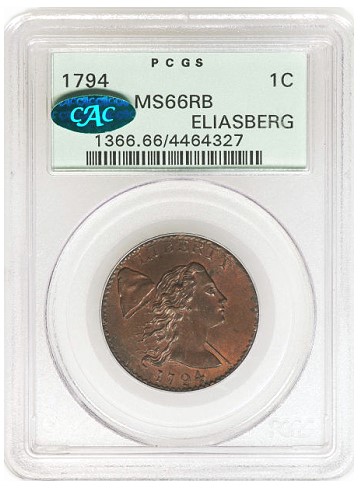 Although this coin brought a large sum of money at the official auction of the Central States convention in Illinois, 1794 large cents in general are not nearly as expensive. In a December 2012 holiday season fixed price list, coin dealer Chris McCawley offered some not certified, circulated 1794 cents that are similar to this one, though struck from slightly different pairs of dies. One that is graded Good-06 by McCawley or Bob Grellman was offered for $425, and an Almost Good-03 grade 1794 cent was offered for $135.
Although this coin brought a large sum of money at the official auction of the Central States convention in Illinois, 1794 large cents in general are not nearly as expensive. In a December 2012 holiday season fixed price list, coin dealer Chris McCawley offered some not certified, circulated 1794 cents that are similar to this one, though struck from slightly different pairs of dies. One that is graded Good-06 by McCawley or Bob Grellman was offered for $425, and an Almost Good-03 grade 1794 cent was offered for $135.
In March 2012, Heritage sold a PCGS-graded AG-03 1794 for $299. In February 2011, an NGC-graded Fair-02 1794 realized $149.50. These were both struck from the same (S-26) pair of dies as this Eliasberg 1794.
This PCGS-certified MS-66RB Eliasberg 1794 cent bought $205,625 on April 25, a moderate to strong price for this coin. Both the consignor and the buyer should be content with this price. On Thursday, January 10, 2008, at a FUN Platinum Night event, this exact coin realized $195,500. In April 2009, when markets for rare U.S. coins ‘bottomed out’, this coin sold for the much lower price of $126,500.
What Are 1794 Large Cents?
Until small cents first appeared in 1856, all U.S. one cent coins were around the size of quarters, much larger than any of the pennies that are now familiar to people in the United States. In my recent two-part series on 1792 half dismes (clickable links are in blue), it is explained that U.S. coins were not struck until 1793. One-cent coins were first produced in that year. All half cents and large cents are almost entirely copper. Small amounts of trace metals contribute to variations in the color of large cents and half cents.
It is curious that, in 1793, three different design types of cents were minted: Chain Cents, Wreath Cents, and Liberty Cap Cents. There are varieties of each of these three types.
Though all 1794 large cents are of a ‘Liberty Cap’ design type, there are dozens of varieties of 1794 cents and many collectors specialize in 1794 cents. All the minor varieties, however, are categorized in terms of three major varieties: ‘Head of 1793’, ‘Head of 1794’, and ‘Head of 1795’. A female “head”, along with a pole and a cap, constitutes the Liberty Cap design element on the obverse. Many U.S. coins feature a female personification of the concept of liberty.
The ‘Head of 1793’ major variety refers to all those 1794 large cents with the Liberty Cap ‘Head’ design that is like the Liberty Cap ‘Head’ design that appears on 1793 Liberty Cap Cents. The ‘Head of 1793’ design element is notably different from the corresponding design elements on 1795 cents, 1796 Liberty Cap Cents, and other 1794 cents.
The ‘Head of 1795’ major variety likewise refers to all those 1794 large cents that feature a Liberty Cap ‘Head’ design that is like the Liberty Cap ‘Head’ design that appears on 1795 and 1796 Liberty Cap Cents. The ‘Head of 1794’ design element does not appear on 1793 Liberty Cap Cents or on 1795 cents.
If three high-grade 1794 cents, one each of the three major varieties, are all placed next to each other, then the distinctions between the three varieties would be readily apparent. It is difficult to explain such differences in words.
Most coin collectors, though, are happy to obtain one 1794 cent, regardless of the features of Miss Liberty’s head. Gem-quality 1794 cents are usually purchased by collectors who are assembling type sets, rather than those who are collecting large cents ‘by date’ (year) or by die variety. I am aware, though, of collections of large cents ‘by date’ or by ‘major variety’ that include many Gem-quality pieces, those grading MS-65 or higher.
In this regard, the Walter Husak Collection was unusual because Husak owned several Gem-quality 1794 cents, even though he was collecting by die variety. Husak’s set was auctioned by Heritage on Feb. 15, 2008. Walter Husak had an incredible group of 1794 large cents, assembled by die variety.
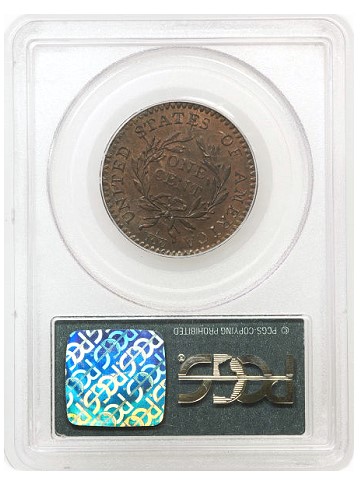 This Eliasberg ‘Head of 1794’ cent is of die variety Sheldon-26 (S-26), which refers to a particular pair of dies that were used to make large cents at the Philadelphia Mint in 1794.
This Eliasberg ‘Head of 1794’ cent is of die variety Sheldon-26 (S-26), which refers to a particular pair of dies that were used to make large cents at the Philadelphia Mint in 1794.
Denis Loring maintains that this Eliasberg 1794 cent is the “finest known of the S-26 variety.” Richard Burdick disagrees and asserts that he recently saw another that is of higher quality and Richard suggests that the Eliasberg 1794 may be the third-finest known S-26.
Few collectors, though, would know the meaning of S-26 and many of those who did have forgotten. Most coin collectors ignore die varieties. Tens of thousands of people collect large cents ‘by date’ and would not care about the S-26 variety. Also, a collector of type coins needs just one Liberty Cap Large Cent for a type set and this one would be a wonderful choice.
Madison Type Set
This Eliasberg 1794 cent was, not long ago, in one of the all-time greatest type sets, the Madison Collection. Most of this set was auctioned by Heritage at the winter FUN Convention in January 2008. Madison is a pseudonym, not the real name of the collector who owned this set.
The depth and significance of this type set has never really been analyzed. Here, a few of the coins in the Madison type set are mentioned to provide an impression of its scope and character.
Madison was certainly serious about his selections of coins to represent Indian Head Eagles ($10 gold coins) in his set. He had a PCGS-graded MS-67 Rolled Edge 1907, one of the highest-certified representatives of a rare and unusual issue. It sold for $460,000. His regular No Motto Indian Head Eagle was a 1907 that is PCGS-graded MS-66 and realized $14,950 on Jan. 10, 2008.
For the most common Indian Head Eagle type, the With Motto coins that were struck from 1908 to 1933, Madison chose the rarest date for his type set, a 1933 Eagle. It is one of the highest certified of this date, PCGS-graded MS-65. It brought $552,000.
One of my favorite gold coins in the Madison type set was his 1869 Double Eagle ($20 coin). Gem-quality, business strike, Type Two Double Eagles are tremendous condition rarities. For a whole design type, which dates from 1866 to 1876, there are very few Double Eagles that grade MS-65 or higher. The Madison 1869 is PCGS-graded MS-65 and is really a neat coin. On Jan. 10, 2008, it realized $299,000.
Madison’s type set was not contained by typical boundaries for a type set of U.S. coins. He included colonials, medals, and foreign coins that circulated in North America. The Madison 1786 New Jersey Copper is PCGS-graded MS-64 and sold for $31,050. It is amazingly sharp for a New Jersey Copper.
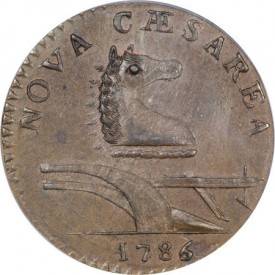 Additionally, Madison had a Vermont Copper, also dated 1786. Like Madison’s 1794 cent, this Vermont Copper was earlier in the Eliasberg Collection. It is PCGS-graded MS-62 and sold for more than $25,000 in 2008.
Additionally, Madison had a Vermont Copper, also dated 1786. Like Madison’s 1794 cent, this Vermont Copper was earlier in the Eliasberg Collection. It is PCGS-graded MS-62 and sold for more than $25,000 in 2008.
Much of the Madison Type Set was comprised of coins that were unusually rare and/or unusual in other ways for a type set. His set included a 1955 Doubled Die Lincoln Cent, a 1916 Doubled Die Buffalo Nickel, a 1937-D ‘Three Legged’ Buffalo Nickel, an 1800 ‘LIBEKTY” die cutting error variety Draped Bust Half Dime, and a Scott Restrike of a Confederate Half Dollar, among other noteworthy pieces.
Madison also had plenty of typical type coins, like 1853 and 1860 Liberty Seated Half Dollars. I remember his really neat 1836 Gobrecht Silver Dollar, which is (or was) PCGS-certified PR-64. The Eliasberg-Madison 1794 cent, though, is even more memorable.
History of Ownership
For a rare U.S. coin, it hard to imagine a better pedigree. In terms of quality, completeness, and important rarities, the Parmelee and Earle collections are among the 10 best U.S. coin collections ever to be sold at public auction. The Eliasberg Collection is number one. This 1794 large cent was in all three.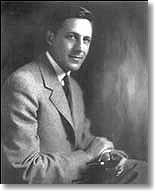
Of the nine 1794 large cents in the Eliasberg Collection, this one brought the highest price, when Eliasberg’s large cents were auctioned in New York on May 21, 1996, by Bowers and Merena. This 1794 cent then realized $34,100, a steep price for a 1794 large cent in 1996. It is not of a rare variety; S-26 cents are not rare overall. In that Eliasberg 1996 auction catalog, it is said to be “MS-65, red and brown.”
In regards to this 1794 cent, I am assuming that the pedigree listed in the Eliasberg 1996 catalog is correct. This same list of owners and auction appearances appears in the April 25, 2013 Platinum Night catalog. Presumably, someone ‘double checked’ this list.
The collection of Lorin Parmelee was auctioned in 1890. One of the treasures included was the 1796 No Stars Quarter Eagle that was later in the Lelan Rogers and Madison collections. It sold for $1,725,000 on Jan. 10, 2008 – an auction record for a Quarter Eagle (U.S. $2.50 gold coin).
Before being part of the Earle Collection, and after the Parmelee Collection was auctioned, this 1794 cent was in the John G. Mills Collection, which was excellent and is under-rated in the history of coin collecting. The firm of the Chapman brothers auctioned the Mill Collection in April 1904 in Philadelphia. According to the 1996 Eliasberg catalog, this cent was lot #1238 in that sale.
Coincidentally, I have an original copy of the Mills catalog. Unfortunately, my copy lacks a set of original photographic plates. Lot #1238 is said to be “Uncirculated [with] Original red luster shading to light olive.” Given the standards and terminology of the time, this is a very positive description. Many coins that are now graded MS-62 by either PCGS or NGC were or would have been termed “Extremely Fine” by the Chapmans.
Several years after the Chapman brothers ended their partnership, the firm of Henry Chapman auctioned the George Earle Collection, in June 1912. The Earle Collection is incredible. A very large number of the coins in this collection have graded or would grade from 66 to 69 in terms of the grading criteria employed by PCGS or NGC. There are indeed dozens of Earle Collection coins that currently are certified as grading 67 or 68.
Quite a few of the highest quality, U.S. coins in the George Earle Collection ended up in the John Clapp Collection, and these were later in the Eliasberg Collection. In 1942, through Stack’s, Louis Eliasberg acquired the Clapp Collection intact for $100,000, which was then an immense amount of money for a coin collection. Eliasberg sold some of the Clapp coins in Stack’s “H.R. Lee” sale in 1947 and he consigned some to a New Netherlands sale in the 1950s. He kept most of them.
When Eliasberg’s U.S. material was auctioned in 1982, 1996, and 1997, most of the Gem-quality, pre-1917 coins included had earlier been in the Clapp Collection. It is curious, though, that this large cent was earlier in the Clapp Collection, as the John Clapp Collection is primarily remembered for superb quality silver and gold coins rather than for copper.
Quality
This Earle-Clapp-Eliasberg-Madison 1794 Chain Cent has been PCGS-graded MS-66 at least since 1999. It is in a PCGS old green holder. The Eliasberg pedigree is stated on the label. For years, it was the only 1794 ‘Head of 1794’ cent this was PCGS-certified MS-66RB. Now, it seems that there are two others, according to PCGS CoinFacts.
There are coins with fake red color that have been PCGS- or NGC-certified as having original red. It is often very difficult for experts to distinguish original red color from red color that is generated by artificial means. This point about valuable copper coins often being doctored and the fact that many doctored copper coins are PCGS- or NGC-certified are put forth in more than one of Scott Travers’ books, along with explanations.
For this 1794 cent, the “RB” designation is accurate and this coin has a substantial amount of original mint red color, in my view. Richard Burdick agrees that “the color is original, though it is more brown than red. There are other 1794 cents that are more red than brown.”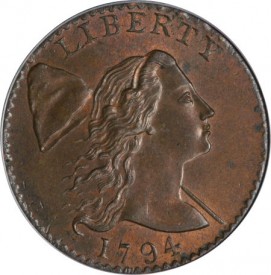
Dave Schweitz, too, when interviewed in Jan. 2008, found that the “brown and red color is natural.” Schweitz is an expert in interpreting the presence of original red color on copper (and he has other areas of expertise).
The color is impressive. After all, this coin was struck in 1794. Most early copper coins have toned completely brown, have been dipped in acidic solutions, have been chemically cleaned, have been contaminated due to environmental factors, or have been artificially colored, in the interim. The color of this coin is very original and very pleasing.
This Parmelee-Mills-Earle-Clapp-Eliasberg 1794, though, does not receive a near-perfect score in the category of originality. It has been brushed and perhaps lightly oiled at one time or another. It is very original, though, much more so than the 99% of the pre-1800 U.S. copper coins that survive.
Specialists in the die varieties of early U.S. copper coins employ a different kind of grading system, which is not practical to explain here. Denis Loring and Mark Borckardt are established specialists in this realm. They both find that this coin has a substantial amount of original mint red.
One of the best aspects of this coin is that it appears to have almost zero contact marks, when viewed with a five-times magnifying glass. Furthermore, it is well struck on a nice planchet. It is technically pristine. A coin may have far more contact marks and still qualify for a 66 grade. Technical factors, though, are not the only factors incorporated into a coin’s grade; surface quality and eye appeal are key factors as well.
In a technical sense, this coin has few flaws. While it is very attractive or so, though, it is not extremely attractive. This coin is characterized by the technical aspects of a 67 grade and the eye appeal of a 65 grade. Its surface quality is commensurate with a 66 grade. Overall, a 66 grade is accurate.
Richard Burdick contends, in contrast, that it should have been certified “MS-65RB, not MS-66RB.” Richard argues that, “if it [were] a true 66, it would have brought $250,000 to $300,000 in the last auction. It brought what it is worth,” Burdick declares.
This is a fabulous coin. Are there any 1794 ‘Head of 1794’ cents that have sold for more?
Though we disagree about the grade of this coin, Richard and I agree that the $205,625 auction result for this coin is a fair market price. Richard and I recollect that the Oswald-Husak S-71, PCGS-certified MS-65RB ‘Head of 1795’ 1794 cent sold for $253,000 on Feb. 15, 2008. Richard accurately declares that the Oswald-Husak ‘Head of 1795,’ PCGS MS-65RB has significantly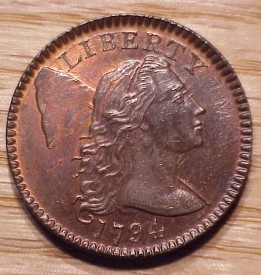 more original mint red than the Eliasberg 1794 cent that is being discussed here. Furthermore, I agree that the fact that Oswald-Husak S-71 is a ‘Head of 1795,’ not a ‘Head of 1794,’ is beside Burdick’s argument that this Eliasberg-Madison 1794 cent is overgraded. I am not alone, however, in insisting that the Oswald-Husak ‘Head of 1795’ S-71 cent is undergraded by PCGS.
more original mint red than the Eliasberg 1794 cent that is being discussed here. Furthermore, I agree that the fact that Oswald-Husak S-71 is a ‘Head of 1795,’ not a ‘Head of 1794,’ is beside Burdick’s argument that this Eliasberg-Madison 1794 cent is overgraded. I am not alone, however, in insisting that the Oswald-Husak ‘Head of 1795’ S-71 cent is undergraded by PCGS.
Some copper experts expected a PCGS grade of MS-67 or higher for the Oswald-Husak coin. Indeed, in the Heritage catalog of the Husak Collection, Borckardt cites two such experts. Moreover, I examined the Oswald-Husak S-71 1794 cent before it was ever certified. I expected experts at the PCGS grade to assign a grade of at least MS-66.
For a few reasons, the fact that the Oswald-Husak S-71, PCGS-certified MS-65RB 1794 cent sold for $253,000 is not evidence that the Parmelee-Mills-Earle-Eliasberg-Madison, PCGS-certified MS-66RB cent is overgraded. The Oswald-Husak piece is undergraded and is just a more exciting coin. Besides, prices at the Husak sale for large cents were, unsurprisingly, stronger than prices for large cents in the recent Platinum Night event of April 25, 2013.
Though Loring employs a grading system that is different from that of most coin experts, the Early American Coppers (EAC) system used by specialists in die variety of early copper, Denis grades this Eliasberg-Madison S-26 1794 Cent above a few other 1794 cents that are each PCGS-graded MS-65. He emphasizes that this Eliasberg 1794 cent is a “real beauty!”
* * *




